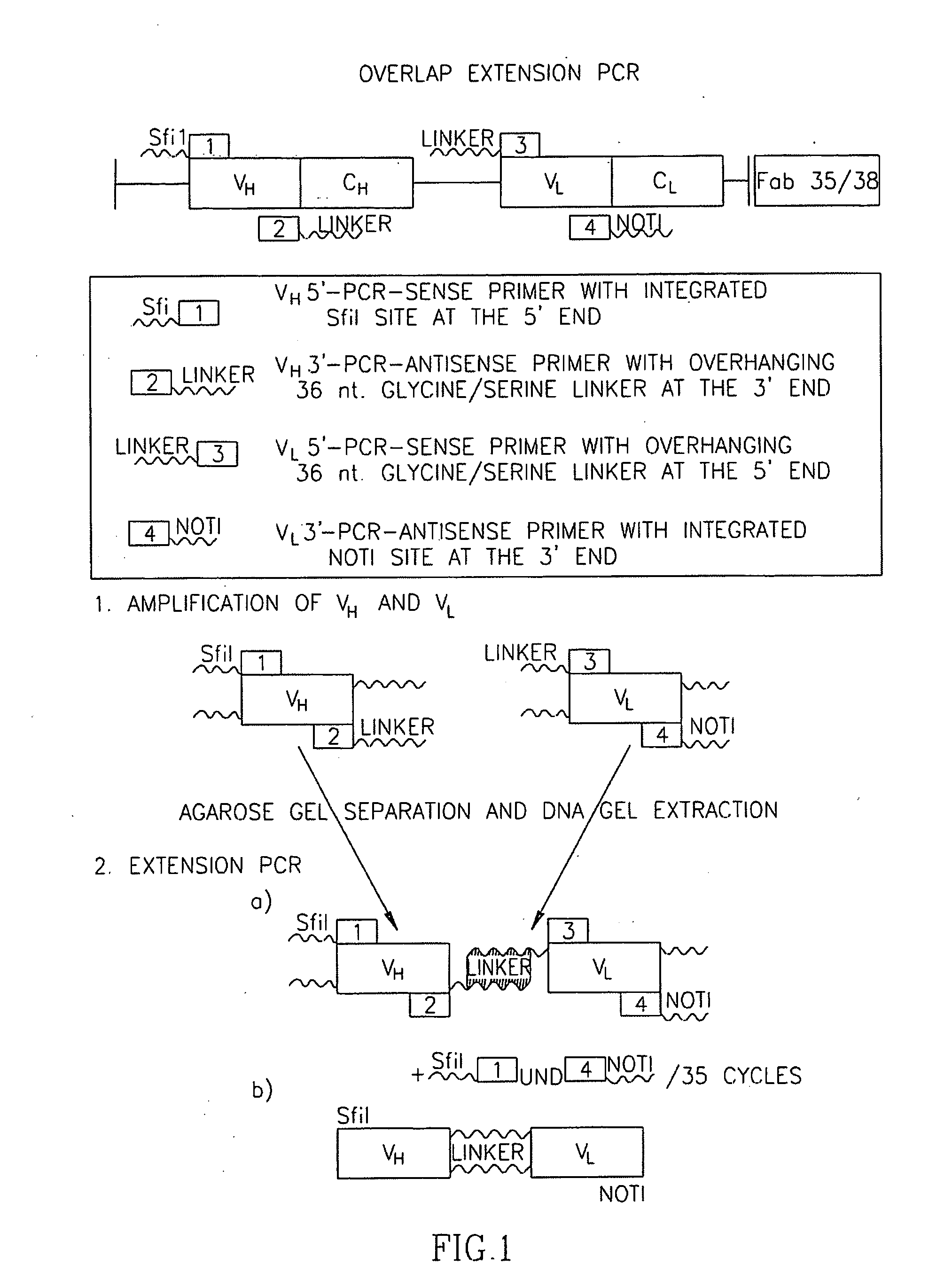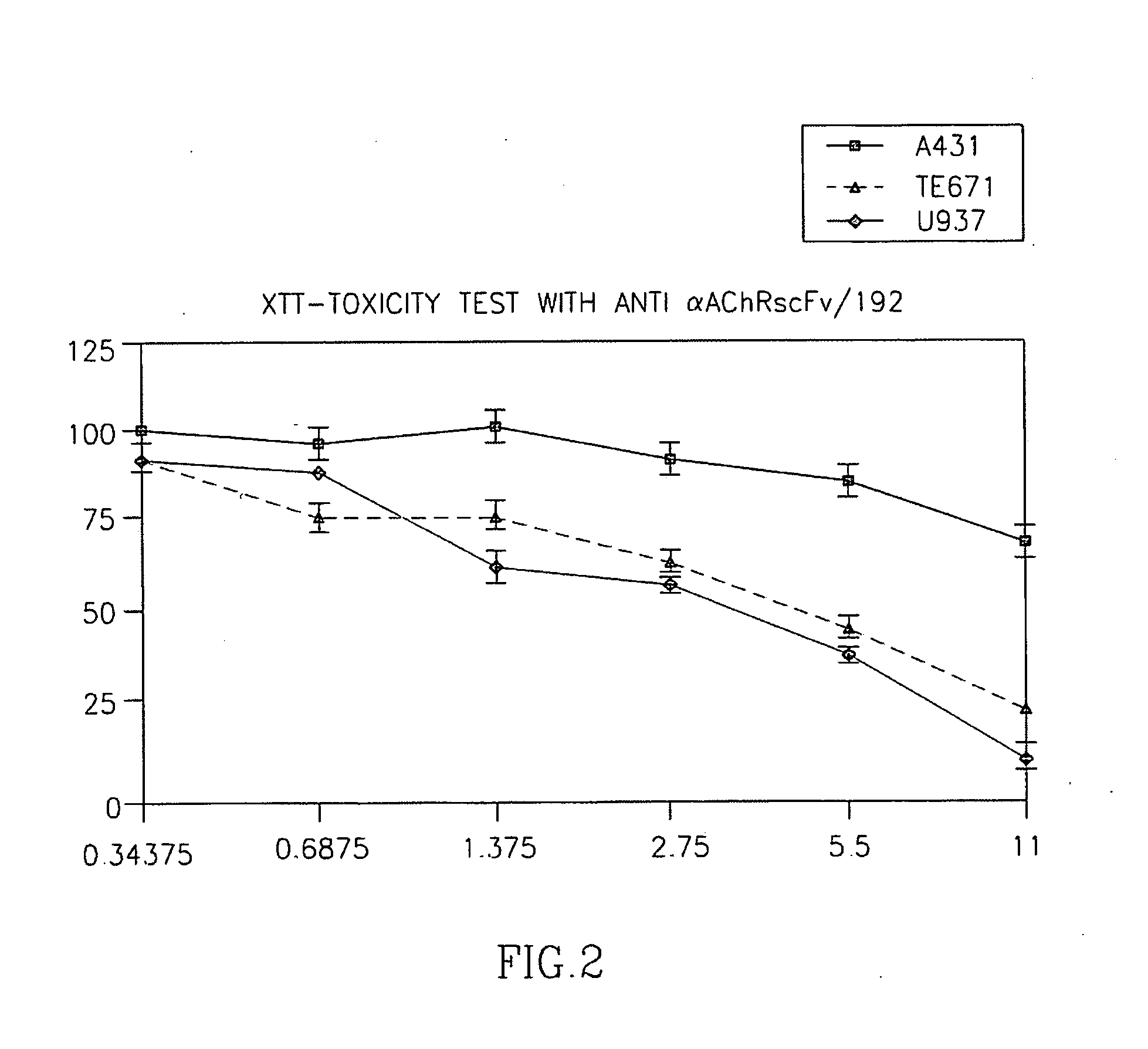Immunotoxin derived from a recombinant human autoantibody and method of using thereof
a human autoantibody and immunonotoxin technology, applied in the field of immunonotoxin derived from a recombinant human autoantibody and its use, can solve the problems of poor prognosis of soft tissue tumours in children, unadjusted immunotherapies or other (e.g. genetic) specific targeting strategies, and inability to achieve the effect of preventing myasthenia gravis and preventing arthrogryposis
- Summary
- Abstract
- Description
- Claims
- Application Information
AI Technical Summary
Benefits of technology
Problems solved by technology
Method used
Image
Examples
example 1
An IT Targeting the Main Immunogenic Region (MIR) of the AChR α-Subunit Kills RMS Cells In Vitro
[0103] In a first step we generated an ETA-containing IT based on a recombinant single chain Fv fragment that had been derived from the well characterized rat monoclonal antibody mAb195 against the main immunogenic region (MIR) of the human AChR α-subunit. This model IT (scFv-195-ETA) specifically bound to several RMS cell lines as revealed by FACS (not shown). Binding of scFv-195-ETA to TE671 RMS cells could be competed using unlabeled scFv-195 (not shown). In addition, scFv-195-ETA killed the RMS cell lines TE671, FLOH-1 and RD in a dose-dependant manner, while non-RMS epithelial, hematopoietic and neurogenic cell lines (A431; U937; IMR32, respectively) without muscular AChR expression were not killed (FIG. 2). These experiments were considered as “proof-of-principle” that specific targeting of the AChR by an IT can kill AChR-positive RMS cells. Since the α-subunit is shared by RMS cel...
example 2
Synthesis of an IT Targeting the γ-Subunit of the Human Fetal AChR In Vitro
[0104] Since the fetal AChR, specified by the γ-subunit, is virtually absent in non-neoplastic innervated skeletal muscle but expressed in most RMS, we generated an ETA-based IT with specificity for the AChR γ-subunit. Synthesis started from two recombinant human Fab fragments (Fab35 and Fab38) that were derived from a combinatorial cDNA library derived from the thymus of a seropositive MG patient with high titers of anti-AChR γ-subunit antibodies. Although cloning of the two Fab fragment cDNAa into the ETA-vector resulted in constructs that were in frame as revealed by sequencing, they were inefficiently translated in transformed E. coli BL21DE3, resulting in several abnormal protein fragments of 70-80 kd instead of the expected 120 kd full-lenghth IT (not shown). Therefore, we used the Fab35 and Fab38 cDNAs to produced single-chain Fv (scFv) fragments by overlap extension PCR (FIG. 1). VH and VL fragments ...
example 3
An AChR γ-Subunit-Targeting Immunotoxin Delays Tumour Development in a Mouse RMS Transplantation Model
[0107] 35 scFvVL-VH-ETA was further investigated for its in vivo killing capacity using RD RMS cells as targets in a RMS transplantation mouse model. Toxicity tests revealed that intravenous injection of 10 μg IT per mouse had no apparent advers effect on the mice tested (n=10) in terms of mobility, weight development, and survival (up to 60 days). Therefore, this dose of IT was co-injected with RD cells (107 per mouse) (n=10) intravenously. Saline injections served as negative controls (n=4). Twice daily injections of 10 μg IT per mouse were repeated up to day 10. Tumour development was monitored by daily inspection and palpation. As shown in FIG. 5, 100% of mock injected mice exhibited palpable tumours day 7 of the experiment, and clearely visible subcutaneous tumours by day 10 (volume: 59+ / −9mm3). By contrast, no or minimal tumours were detectable in IT-injected mice by day 4 an...
PUM
| Property | Measurement | Unit |
|---|---|---|
| tumour volumes | aaaaa | aaaaa |
| flow rate | aaaaa | aaaaa |
| pH | aaaaa | aaaaa |
Abstract
Description
Claims
Application Information
 Login to View More
Login to View More - R&D
- Intellectual Property
- Life Sciences
- Materials
- Tech Scout
- Unparalleled Data Quality
- Higher Quality Content
- 60% Fewer Hallucinations
Browse by: Latest US Patents, China's latest patents, Technical Efficacy Thesaurus, Application Domain, Technology Topic, Popular Technical Reports.
© 2025 PatSnap. All rights reserved.Legal|Privacy policy|Modern Slavery Act Transparency Statement|Sitemap|About US| Contact US: help@patsnap.com



